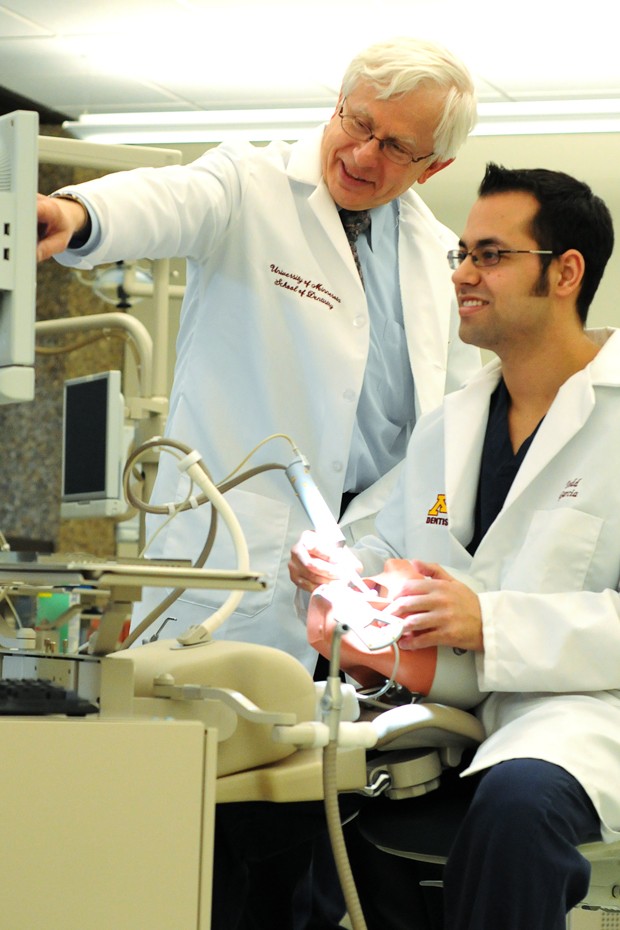The six schools and colleges that reside within the University of MinnesotaâÄôs Academic Health Center are rapidly beefing up their e-learning offerings âÄî a trend experts say only makes sense when it comes to health education. âÄúE-learning is becoming incredibly core to what we do here,âÄù said Barbara Brandt , assistant vice president for education in the AHC. The rumblings will culminate in the unveiling of the AHCâÄôs Office of e-Learning , anticipated to happen this spring. E-learning is a broad term that includes all forms of technology-enhanced education. Its most common format is a blended course that incorporates both online and face-to-face instruction. About 1,400 e-learning courses are currently offered at the University. When it comes to learning about medicine, thereâÄôs so much information, itâÄôd be impossible to teach students about every disease or new drug thatâÄôs available, said Kari Franson , associate dean for professional education in the department of clinical pharmacy at the University of Colorado Denver . âÄúLearn this on your own time,âÄù she said. âÄúThatâÄôs more consistent with todayâÄôs students, with how digitally connected they are.âÄù The way students live their lives âÄî doing everything from planning ski trips to maintaining long-distance friendships online âÄî is now inconsistent with the way theyâÄôre educated, going to a classroom to hear a lecture. Franson, who created online content for her pharmacology curriculum, said e-learning fills that disconnect. âÄúI really think that weâÄôre using e-learning for the learners today,âÄù she said. âÄúI think they expect it.âÄù E-learning and U In the School of DentistryâÄôs advanced simulation clinic , second-year student Todd Garcia fills a cavity on his patient âÄî a mannequin with a realistic set of teeth. His drill is covered in computer-driven infrared lights and every time he touches it to a tooth, his work appears on the screen before him. When heâÄôs through, the computer gives him a grade and an image of his work. âÄúThe computer is the teacher,âÄù dentistry professor Peter Berthold said. The 2-year-old simulation lab âÄî estimated to cut learning time in half âÄî is one of several ways dental students and faculty benefit from advancements in technology. As seniors work in dental clinics throughout the state, they can watch lectures broadcast from the University, said Judith Buchanan , the schoolâÄôs associate dean for academic affairs. Simulations and various online methods of learning procedures allow students to refine the psycho-motor skills that are vital to performing surgery and other complex medical procedures, Brandt said. The School of Public Health has been a leader in e-learning for years, Debra Olson , associate dean for education, said. âÄúPublic health is global health,âÄù she said. âÄúItâÄôs access to learning opportunities for individuals from whatever community they reside.âÄù The school offers everything from online graduate and undergraduate courses to distance-based degree programs, she said. As the Medical School reorganizes its curriculum in the face of dramatically-reduced state funding, e-learning is âÄúabsolutely critical to our future,âÄù Dean Frank Cerra said in a December speech . Sweeping the nation As medical schools across the county get bigger, faculty members have more students to teach. Fortunately, much of the information students need to know at the outset of their training âÄî the basic science behind diseases and treatments âÄî doesnâÄôt require a human tutor. In fact, time with faculty members can be more effective if students know the basics ahead of time, said Rosanne Leipzig , geriatrics professor at the Mount Sinai School of Medicine in New York City. âÄúThen, when you actually meet with a faculty member and a patient, the faculty member can spend time really seeing what youâÄôre able to do and how youâÄôre able to do it rather than teaching you the basics,âÄù she said. E-learning courses tend to free up time professors can then use to pursue money-making endeavors such as research or clinical practice, Franson said. Although this benefits the University, the highest benefit of e-learning is to the students, she said. In May 2009, the U.S. Department of Education performed a 12-year meta-analysis on 51 different studies of online learning. The results showed that, on average, students who received part or all of their instruction online performed better than their peers who learned the same material using traditional face-to-face instruction. âÄúItâÄôs kind of like âÄòUh oh,âÄô âÄù Franson said of the finding. âÄúI think that result is kind of waking people up a bit.âÄù









